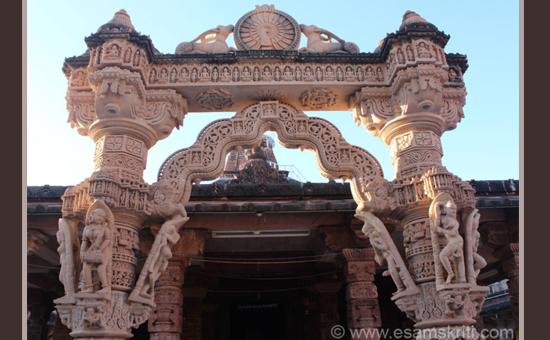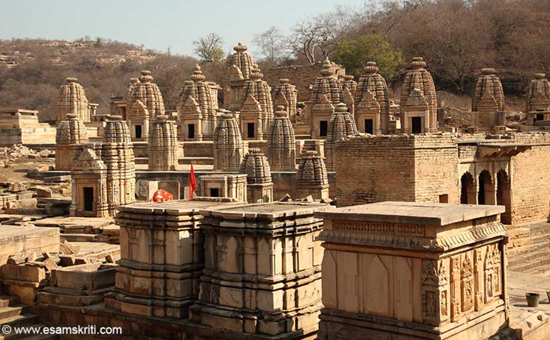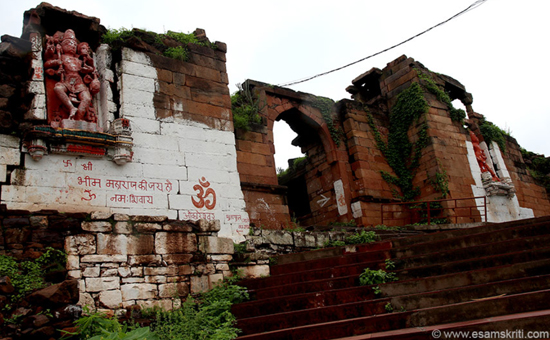- Article tells about individual kings of the Pratihara
Empire. The
Pratiharas stood as a bulwark against aggression of the Muslims.
During a visit to Gwalior Fort saw Teli-ka
temple. Impressive. The ASI board said it was made during the reign
of a Pratihara king Mihira 9th century. During the same trip saw Bateshwar
Temple, Morena which was made by the Pratihara kings (6-9th
century). As I looked back, realized that the lovely Jain
temple in Osian near Jodhpur was also made a Pratihara king
Vatsaraja and dated back to 783 A.D.
Next question who were the Pratiharas? What
period did they rule and what parts of India? This compilation tells about the
Pratihara kings and empire. The key kings were Nagabhata I, Nagabhata II, Mihir
Bhoja, Mahendrapala etc.
In 712 the Arabs
conquered Sindh. About 725 its Governor Junaid, sent an army for the conquest
of India. It overran Saurashtra etc. and reached Ujjayani. Nagabhata belonged
to the Pratihara family, rallied the warriors of the allied clans of the
Pratiharas, Chaahamanas and perhaps Chalukyas and defeated the invaders. His
defeat of the Arabs made him a national hero.
Kulapati K M Munshi wrote that, “Under the Pratihaas, Kanauj reached the zenith of power, (815-940). Its rulers were called Gujaresvaras; in a later inscription, Gurjara-Pratiharas.” Kanauj or Kanyakubja continued to be the most influential centre of culture till 1018 A.D. when it was dethroned by Mahmud of Ghazni. Pg. x
Under the Pratihars, Kanauj reached the peak of power, learning and culture during 815-940. Decline of the Pratihara Empire brought into prominence new powers, known later as RAJPUTS. Munshiji wrote, “Many of the Rajput rulers who surrendered power in 1947-48 were descendants of the feudatories and generals of Mihir Bhoja.” Pg.xi
This article is compiled
based on Volume 4 of The History and
Culture of Indian People published by the Bharatiya Vidya Bhawan. All credits to authors of volume.
About
Pratihara Kings
Nagabhata I (730-756
A.D.)
The family came
into prominence in the second quarter of the 8th century by successful resistance to the Arabs. They stood as a bulwark against the Muslims of the Sindhu Valley. R. C. Mazumdar wrote, “Muslim writers wrote that whenever the Pratihara armies advanced the Muslims threatened to destroy the famous image of the Sun-god
in Multan, so the Pratiharas retreated.”
Not much is known
about the ancestors of Nagabhata I. He might have ascended the throne around
730 and probably ruled till 756. Whether he defeated Junaid or his successor
Tamin is not clear. According to “Prithviraj Raso, the imperial legend of the dynasty tells us that the dynasty descended from the ‘Agnikula’ clan of the Rajputs. The royal dynasty derived their origin from a Yagna Kunda at Mount Abu.” Source
Inspite of various
wars, some losses, Nagabhata I left for his successors a powerful principality
consisting of Malwa, parts of Rajputana and Gujarat.
Vatsaraja
His brother’s son Vatsaraja was a powerful ruler. Jain monks refer to him in their writings. He is said to be the King of Avanti in 783 A.D. He is said to have ascended the throne in or before 778 and his kingdom comprised Malwa and eastern Rajputana.
He is said to have
expanded his kingdom in the North and defeated the Lord of Gauda, perhaps the
king of Bengal. Vatsaraja was defeated by the Rashtrakuta king Dhruva. After
his defeats not much is known of Vatsaraja.
The Jain Temple at
Osian near Jodhpur was made by Vatsaraja in 783.
 Jain Temple Osian.
Jain Temple Osian.
Nagabhata
II (Date
not sure to 834)
He is the son of Vatsaraja and as per a Gwalior inscription the rulers of Andhra, Vidharbha, Kalinga and Saindhava chiefs (ruling in West Kathiawar) lost to him. He also won control of many hill-forts. However, he was defeated by Rashtrakuta king Govinda III who overran his dominions and reached by the Himalayas (war took place before 809-810). Although Nagabhata II’s ambitions were curbed his power was not destroyed. Pg. 27
Nagabhata II probably
occupied Kanauj (near Kanpur) and made it the permanent capital of the
Pratiharas. Per records Nagabhata II scored a great victory over his Pala rival
king Dharampala. Pg. 26
On the whole it
can be said that Nagabhata II exercised his sway on the large part if not the whole
of Rajputana and Kathiawar Peninsula. In the east his sway extended up to
Gwalior and probably further east so as to include Kanauj and Kalanjara.
Inspite of little
information available on Vatsaraja and Nagabhata II their reigns occupy a
prominent place in the contemporary history of India. Both had a high degree of
military skill, and the defeat by the Rashtrakutas cannot reduce their glory
because they achieved military victories from one end of north India to
another. They did not head a stable empire but laid the foundations well for
king Bhoja (grandson of Nagabhata II) to build a great empire.
 Bateshwar Temples Morena, MP built 6-9the century during Pratihara rule.
Bateshwar Temples Morena, MP built 6-9the century during Pratihara rule.
Mihira
Bhoja (836-885)
It is likely that by 836 Bhoja had fixed his capital at Kanauj and obtained mastery of the region around it, which was probably lost during his father’s reign.
The Jodhpur Pratiharas probably regained independence during the reign of Bhoja’s father Ramabhadra. By 843 Bhoja had reasserted his authority over Gurjaratra or Central and Eastern Rajputana.
Bhoja was defeated by the Pala king Devapala between 845-860 and by Rashtrakuta king Dhruva. He also lost control over part of Rajputana during 843-861. Post Devapala’s death Bengal became weaker.
Rashtrakuta king Amoghavarsha
(814-878) was of religious disposition. Taking advantage Bhoja invaded Bengal
and inflicted a crushing defeat on king Narayanapala. He also defeated Rashtrakuta
king Krishna II (878-914). He occupied Malwa and headed towards Gujarat. He
lost his hold upon Kaira District although he maintained supremacy over the
whole of Kathiawar. In the north-west his dominions extended to Punjab. In the
east the Kalachuris of Gorakpur were his feudatories and probably the whole of
Awadh was included in his domain. The Chandellas of Bundelkhand too
acknowledged his overlordship.
With this Bhoja
created a mighty empire that his ancestors dreamt of. His capital Kanauj rose
to the position of an imperial city once again.
An Arab account of
India composed in 851 and attributed to Sulaiman refers to the great power and
resources of Bhoja. He is unfriendly to the Arabs, still he acknowledges that
the king of the Arabs is the greatest of the kings. Among the princes of India,
there is no greater foe of the Muslim faith than he.
He stood as a
bulwark of defence against Muslim aggression. Bhoja was undoubtedly one of the
outstanding political figures of the 9th century and ranks with
Dhruva and Dharampala as a great general and empire-builder. Unlike others what
he conquered he consolidated as well.
“Al-Masūdi, the Baghdadi visitor of early 10th century, refers to Bhoja-Bauura (a corruption of title Varāha) as ‘the lord of the city of Kannauj’ and as ‘one of the Kings of Sindh’. “He has large armies in the garrisons on the north and on the south, on the east and in the west; for, he is surrounded on all sides by warlike kings….Bauura, who is the king of Kannauj, is an enemy of Balharā (Vallabha Rāja, the title of Rashtrakuta emperors), the king of India.” He adds that Bhoja, “has four armies, according to the four quarters of the wind. Each of them numbers 7 to 9 lakh men. The army of the north was against the prince of Multān, and with the Musalmans, his subjects, on the frontier. The army of the south fights against the Balhara, king of Mankir (Manyakheta).” Source
Pragyata.com
Munshiji wrote, “The Pratihara emperors formed the spearhead of this religious and cultural upsurge. Some like Bhoja worshipped Bhagvati as their guardian deity, others Siva and Vishnu. They maintained the tradition of being the protectors of dharma. While
they led the country to progress, they drew upon and social and spiritual
energy of the people. The reciters of the Puranas
became as powerful, if not more, as Brahmanas specialising in ritualism, philosophy or literature. The Brahmins of Kanyakubja played a great role during this period.” Pg. xv
Mahendrapala (885-908)
He maintained in tact his father’s empire and added Karnal district of modern day Haryana, Nepalese terrain and Rajshahi district of Bengal. Pg xxii.
R.C. Mazumdar wrote, “The Pratiharas under Bhoja and Mahendrapala, brought under their direct administration a vast extent of territory, from the Kathiawad Peninsula in the west to Northern Bengal in the east. No such empire flourished in North India after the Guptas. It had a more stable and organised administration than the empire of Harsha-vardhana.” It breaks the wrong notion
that Harsha was the last builder in Northern India.
Mahipala (912
to about 930)
Mahipala not only
maintained the empire inherited by him but probably even extended it in the
early part of his reign. However, Rashtrakuta king Indra III defeated Mahipala
and occupied Kanauj. Like earlier, the Rashtrakutas did not stay long enough to
consolidate their conquests in the north.
It is to the
credit of Mahapala that he survived the above attack and re-established the
fortunes of his family, helped by powerful feudatories. It is not known if
Mahipala recovered all territories. But in 931 his empire extended up to
Saurashtra in the west and Kashi in the east. As late as 946 the Pratihara Empire
included Malwa.
Over the time the
feudatories asserted independence and the Pratihara Empire disintegrated.
Instead rose were the Chandellas, Chedis and Paramaras.
 Eastern gateway, Mandhata Fort Omkareshwar built by the Parmar rulers 13th
century.
Eastern gateway, Mandhata Fort Omkareshwar built by the Parmar rulers 13th
century.
Many rulers
prevailed to the imperial throne during 945-960. There was a steady decline in
Pratihara power. A second expedition by Rashtrakuta king Indra III about 963
gave a final blow to the Pratihara Empire. New powers like the Kalachuris in Central
India, the Paramaras in Malwa and the Chaulukyas in Gujarat weakened the empire
too. About the middle of the 10th century the empire disintegrated
and was reduced to the territory around Kanauj.
Rajyapala, ruled
over the small kingdom of Kanauj till it was swept away by the invasions of
Sultan Mahmud.
Out of the ruins
of the Pratihara empire arose powerful states Chauhans in Rajputana, Chalukyas
(Solankis) in Gujarat and Parasmaras (Pawars) in Malwa.
General
Review of the Pratihara Empire
It was the last
great empire in North India before the Muslim conquest. From the days of Junaid
(725) to those of Mahmud of Ghazni the Pratiharas stood as a bulwark against
aggression of the Muslims.
The Pratihara line
was distinguished for its long succession of able rulers. Apart from its founders,
4 remarkable kings were Vatsaraja, Nagabhata II, Bhoja and Mahendrapala who
ruled for a century and a half with a short break of 3 years. They created a
tradition of imperial glory which survived many rude shocks. It is reflected in
the literary works of Raja-sekhara, the last Indian who could with justifiable pride, refer to his royal patron as “the Maharajadhiraja of Aryavarta”. Pg. 40
NOTE that Mahumd Ghazni’s son, Masud Ghazni invaded India with an army of more than 100,000 men in May 1031 AD. He was defeated by Raja Sukhdev in the Battle of Bahraich in 1033. The victory was so resounding that no Muslim king from the Northwest dare to invade India from 1033 to 1187 A.D. To read about the Battle
of Bahraich
To
see albums of three monuments made by Pratihara Kings
1. Teli-ka-Mandir
Gwalior Fort
2. Bateshwar
Temples, Morena near Gwalior
3. Jain Mandir Osian ie near Jodhpur
Also
read about
1. Mihir
Bhoja and Pratiharas
2. Morena – Architectural workshop of the Gurjara-Pratiharas
We are doing short
precis on Hindu kings before and during the Muslim invasion. The first was About
Vijayanagara Kings-Empire, this is the second. Do mail in feedback
and suggestions.
Reference
1. Volume 4 of The History and Culture of Indian People published
by the Bharatiya Vidya Bhawan. Pictures by Sanjeev Nayyar.